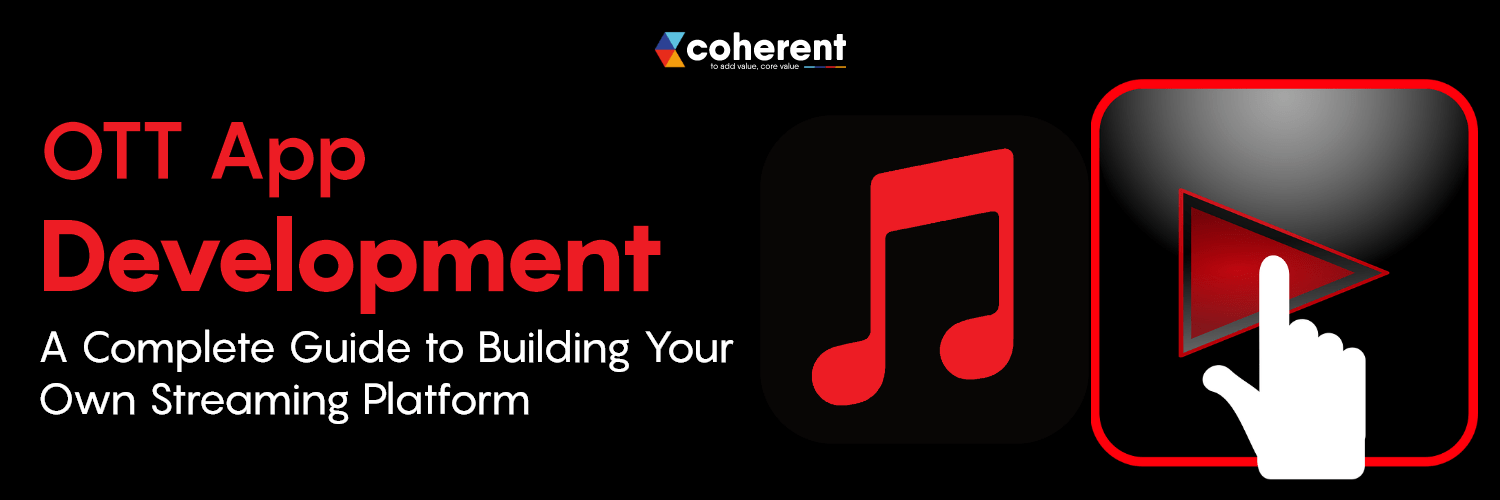OTT App Development: A Complete Guide to Building Your Own Streaming Platform

OTT app development (also referred to as over-the-top) has today emerged as the leading digital entertainment source. Users have started preferring on-demand streaming on multiple devices, ranging from watching movies and television series to live sporting events and learning programs. The rapid evolution of technology and consumer behaviour has made OTT app development a popular business venture. Creating an OTT platform enables content producers and commercial enterprises to reach a worldwide audience without using conventional media services. There are also various factors to consider for OTT app security, such as the requirements to meet the full app development process, features, technologies, cost and monetizing methods, which we shall be looking into in this guide.
What is an OTT Platform?
An OTT platform distributes music, video or other media via the internet instead of using cable or satellite services. Some of the popular examples are Netflix, Amazon Prime Video and Disney+. OTT platform development enables businesses to offer content to users anytime and anywhere. OTT content may involve movies, live TV, podcasts, educational videos and even interactive learning platforms. In contrast to conventional broadcasting, OTT streaming platforms do not limit content consumption and delivery in any way.
Read More: How to Create a Video Streaming App like Netflix?
Key Features of a Successful OTT App
An OTT app development company involves the app’s usability, design and functionality, which all play a major role in its success. Among the main features are:
User Registration and Profile Management
Users should be able to register easily and create secure profiles. Personalized accounts improve the overall user experience. Profile-based features also allow content suggestions for individual users.
Content Categorization and Suggestions
The app should make smart suggestions based on the user's choices. The ability to rely on recommendations offered by AI makes finding content easy and intriguing. The usability is improved with proper classification according to genre, language or popularity.
Advanced Video Player
High definition pictures and distinct, hard-hitting sound are what matter and your content should be in HD, 4K or even Dolby audio. The video player should ensure seamless playback and support adaptive streaming. Features like subtitles and playback controls add to convenience. A high-quality player keeps viewers engaged. In addition to increasing viewer delight, consistently faultless streaming fosters enduring audience devotion.
Support for Multiple Devices
The app should work on web, iOS, Android and smart TVs. The multi-device access expands the availability of content and the flexibility of users. Responsive design, and more importantly, adaptive interface are the main elements ensuring that the interface can be used on every screen and device. The cross-device syncing makes it better also.
Payment and Subscription Options
The app should offer flexible subscription plans for all user needs and engage safe payment gateways. Secure payment instruments would be credit/debit cards, online wallets and local payment methods, which would ensure the reduction of transaction failures and provide a smooth checkout process. The app should also allow users to upgrade, downgrade or cancel their plan easily.
Search and Filter Tools
An effective search bar enables users to quickly locate what they’re looking for. Filters like genre, language and release year improve navigation. The procedure is made simpler by including voice search and filtering options. Users stay on the app longer when they can easily find things.
Push Notifications
The app should send notifications with news of new material, deals or personalized messages. Push messages notify people about the app. Timely messages enhance user engagement and improve retention.
Offline Viewing and Watch History
Users must be able to download and view offline too. This ability to view offline allows viewers to download movies to watch later at their own convenience because not all people have access to the internet at all times too. A watch history log helps resume playback anytime. This feature supports convenience and user satisfaction.
These features improve user satisfaction and help your platform compete with the best ott apps available in the market.
Step-by-Step OTT App Development Process
Developing a successful OTT application should be a well-organised process to guarantee quality, surge and user pleasure. All these steps are crucial in the planning and eventual implementation of the app, and consequently, the use of the same. We have compiled a step-by-step process of how you can come to terms with the entire process of developing an OTT app.
Market Research and Niche Selection
You need to conduct research into your target audience and know their viewing habits before embarking on the development process. Select one niche because, with entertainment, sports, news or education niche, you have a content library that is focussed. A specific niche will make your platform prominent and attract regular users.
Business Model Planning
An OTT app developer should select a revenue model that suits their content and user base. Common business models include:
- Subscription Video on Demand (SVOD)
- Transactional Video on Demand (TVOD)
- Ad-Supported Video on Demand (AVOD)
- Hybrid Models combining two or more monetization methods
Each model has its advantages depending on your long-term goals.
Content Licensing or Original Production
You can either license content from other providers or produce original content. The costs may be minimized by licensing, but original content is more likely to add value to the brand and users in the long-term perspective. Original content gives your platform a unique edge in the competitive OTT market.
Choosing the Right Tech Stack
Choosing the right technology stack is important for ensuring performance and scalability too. Your backend may be based on such frameworks as Node.js or Django but React Native or Flutter can be used as the frontend. Streaming in cloud platforms such as AWS or Azure, or CDN services, is fast and secure. A reliable mobile app development company in USA can guide you through these decisions based on your business needs.
UI/UX Design
Its interface must be modern, responsive and clean. When users have a flawless experience, they are willing to watch more and engage more. Familiar and easy navigation systems, personalized sections and dark mode design are the design trends in OTT systems.
App Development
Backend and frontend integration is part of the development process. The API needs to work with video uploads, profile, analytics and more. An experienced android app development company in USA can help build scalable OTT apps that run efficiently on Android-based smartphones and tablets.
Launch and Deployment
Once development is complete, your application can be deployed to app stores and the web. Make sure that you have a good marketing campaign and an onboarding strategy for the user behind your launch. To maximize your reach, consider partnering with an iOS app development company in USA for smooth deployment and optimized performance.
Also Read: Music Streaming App Development (Working, Features, Types and Cost)
Cost to Develop an OTT App
The amount of money required to create an OTT app is dependent on various aspects. These are not only the features of the app, but also the complexity of the user interface and the platforms it supports, e.g., iOS, Android, Web, Smart TV, etc. It is also based on the storage of the content, the infrastructure requirements of streaming and the size of the team. The location of the development partner plays a key role as well. Partnering with a cross platform app development company in USA may cost more than working with smaller teams. However, it can offer better quality, faster delivery and expert support. A basic OTT MVP may start at $20,000, while a full-featured app can cost over $100,000.
Conclusion
The OTT app development is a promising avenue for content makers, start-up companies and businesses. Proper plan, design and technology will enable you to roll out a successful platform to cater to the highly demanding on-demand entertainment. You have an option of developing a new application or you can fine-tune what you have, but whichever product you might be developing, the team that would ensure that you have a scalable and secure product is the appropriate development team. In the OTT competition, you must stress quality and stream with ease and user experience.
Frequently Asked Questions (FAQs)
Q1. How much time does it actually take to develop OTT app?
Developing an OTT app takes time and the timeline will vary based on the features included, the chosen platform, design complexity and backend integration too. The development of a typical OTT app with standard functionality on average takes roughly between three to six months. An enterprise-level app with a full suite of features may take six months to several years to develop especially if it involves custom functionalities or original content integrations too as well.
Q2. What are the most effective monetization strategies for OTT apps?
Various monetization models exist which include subscription-based, pay-per-view, ad-supported as well as freemium. The good and the bad of each of these models relate to the audience, the type of content and the objectives of your business. The subscription models will result in recurring revenue, whereas models using ad sponsorship do better in terms of reaching a larger audience. It is also possible to mix several models to reach income diversification and flexible access for users.
Q3. Can I launch an OTT platform without original content?
Yes, you are able to start an OTT app with licensed or syndicated content offered by a third party. This practice will make you start your platform quicker and also become cost-effective. Nevertheless, it is easier to create your original content and develop your brand identity and user loyalty in the long term. Many of today’s successful platforms started with licensed content and gradually transitioned to producing their own original content.
Q4. What are the legal considerations when launching an OTT app?
Legal compliance is crucial when launching an OTT platform. All streamed content must have proper licensing and you must adhere to copyright regulations. There should also be adherence to privacy laws, i.e., GDPR or the CCPA, which safeguard user data. What is more, there might be certain broadcasting or digital distribution regulations in your region. It is recommended to consult legal experts prior to launch.
Q5. Which platforms should I actually prioritize when launching my OTT app?
To be effective, the launch strategy should rely on your target users and budget. Under ordinary circumstances, Android and iOS platforms are important because of their presence in the global market and the dominance of mobile-first behaviour. Versions on the web play a critical role in reaching a wider audience too. Carrying out smart TV apps and streaming device systems can be done subsequently as you get momentum. The staged implementation will control the expenses and will allow the integration of user feedback without problems.
Q6. How can AI improve content recommendations in OTT apps?
AI analyzes user behavior and viewing patterns to suggest personalized content, increasing engagement and watch time.


 +91 774-202-1725
+91 774-202-1725
 +1 (945) 3387904
+1 (945) 3387904
 business@coherentlab.com
business@coherentlab.com +49 15223341304
+49 15223341304 UK
UK

